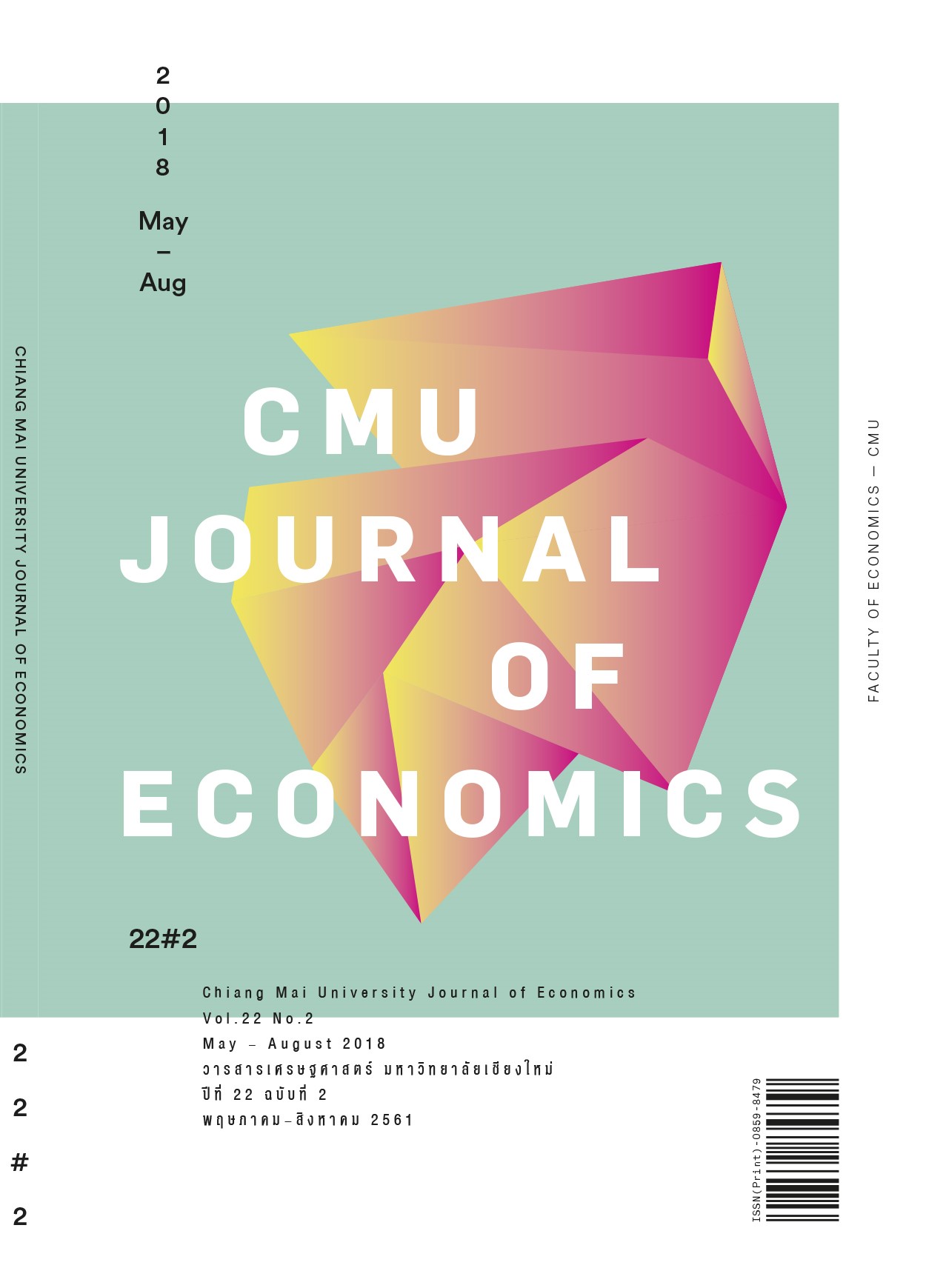Regime-switching Cointegration and Error Correction Modelling for the Rubber Prices in Thailand and TOCOM Market
Keywords:
Rubber prices, intermittent cointegration, Thailand, ราคายางพารา, ความสัมพันธ์เชิงดุลยภาพระยะยาวแบบไม่ต่อเนื่อง, ประเทศไทยAbstract
This study tests relationships between the prices of Thailand’s unsmoked rubber sheet No. 3 and the ribbed smoked sheet No. 3 from the TOCOM market using the Markov-Switching Error-Correction Model. The results show different patterns of relationships in different regimes. Regime 1 is the time period from January 1986 to September 1997 and Regime 2 is from October 1997 to December 2016. In Regime 1, the results show only a significant short-run relationship between the Thai and TOCOM prices, but no significant long-run relationship. In Regime 2, the results show significant relationships between the Thai and TOCOM prices both in the short-run and long-run. A potential key factor contributing to the change in the regimes in 1997 is Thailand’s resignation from the International Natural Rubber Organization (INRO) in 1992. Thai rubber price was affected less by the INRO’s price intervention and more by the Thai government’s policies. Different price regulations and policies overtime led to different price transmission patterns and different relationship in the Thai rubber price and the TOCOM prices.
การศึกษานี้ทดสอบความสัมพันธ์ระหว่างราคายางพาราแผ่นดิบชั้น 3 ในประเทศไทยและราคายางพาราแผ่นรมควันชั้น 3 ในตลาด TOCOM โดยวิธี Markov-Switching Error-Correction Model พบว่าความสัมพันธ์ของราคาในระยะยาวมีการเปลี่ยนแปลงตามภาวะของตลาด โดยภาวะที่ 1 คือ ช่วงเวลาตั้งแต่เดือนมกราคม พ.ศ. 2529 ถึงเดือนกันยายน พ.ศ. 2540 และภาวะที่ 2 คือ ช่วงเวลาตั้งแต่เดือนตุลาคม พ.ศ. 2540 ถึงเดือนธันวาคม พ.ศ. 2559 ในภาวะที่ 1 ราคายางพาราในประเทศไทยและตลาด TOCOM มีเพียงความสัมพันธ์ในระยะสั้นแต่ไม่มีความสัมพันธ์ระยะยาวต่อกัน ในภาวะที่ 2 ราคายางพาราในประเทศไทยและตลาด TOCOM มีความสัมพันธ์ทั้งในระยะสั้นและระยะยาวต่อกัน ทั้งนี้ปัจจัยที่สำคัญปัจจัยหนึ่งของความสัมพันธ์ของราคาที่เปลี่ยนแปลงไปในปี พ.ศ. 2540 นั้น คือ การออกจากการเป็นสมาชิกองค์การยางธรรมชาติระหว่างประเทศ (INRO) ในปี พ.ศ. 2535 เป็นเหตุให้ราคายางพาราในประเทศไทยถูกแทรกแซงโดย INRO น้อยลงและรัฐบาลไทยมากขึ้น การแทรกแซงราคาและนโยบายที่แตกต่างกันในแต่ละช่วงเวลานั้นส่งผลให้เกิดการส่งผ่านราคาที่เปลี่ยนแปลงไปและความสัมพันธ์ระหว่างราคายางพาราในประเทศไทยและราคา TOCOM นั้นเปลี่ยนแปลงไป
References
Charoensakulwong, J., & Kaewbunjong, N. (2003). Tripartite rubber cooperation (Thailand, Indonesia and Malaysia) and effects on rubber businesses. Bank of Thailand, Southern Region Office. (in Thai).
Conforti, P. (2004). Price transmission in selected agricultural markets. FAO Commodity and Trade Policy Research Working Paper, 7.
Ihle, R., & von Cramon-Taubadel, S. (2008). A comparison of threshold cointegration and Markov-switching vector error correction models in price transmission analysis. In Paper presented on the NCCC-134 Conference on Applied Commodity Price Analysis, Forecasting and Market Risk Management, USA: St. Louis.
Jarenmoon, A., (2006). An Analysis of Market Integration and Price Forecasting of Ribbed Smoked Sheet no.3 of Thailand. (Master’s Thesis), Kasetsart University. (in Thai).
Jatuporn, C., & Sukprasert, P. (2016). Price integration analysis among rubber markets of Thailand. RMUTT Global Business and Economics Review, 11(2). 59-92. (in Thai).
Leelasetavong, P. (2013). Government development policy towards rubber fund cooperatives: a case study in the eastern region provinces, Rayong, Chonbury and Trad. (Ph.D. Thesis), Burapha University. (in Thai).
Ministry of Commerce. (2017). Thailand’s top 10 exports. Retrieved from https://www2.ops3.moc.go.th/ (in Thai).
Pastpipatkul, P. (2001). Relationships between rubber spot prices in Thailand and rubber futures prices in the overseas exchanges. (Master’s Thesis). Chiang Mai University. (in Thai).
Romyen, P. (2005). [Computer file]. Evaluation of Thailand’s stage six intervention program of rubber market. Department of Agriculture Library. Retrieved from https://lib.doa.go.th/multim/BB00530.pdf (in Thai).
Somboonsuk, B., Wetprasit, P., Niyombandith, T., Kaesaman, A., & Tekasakul, P. (2013). [Computer file]. Solution guideline for rubber price problem. Prince of Songkla University. Retrieved from https://www.psu.ac.th/sites/files/n6062_doc130906.pdf (in Thai).
Tantiwanitchanon, T. (2011). Price transmission in rubber futures. (Independent study). Thammasat University. Bangkok. (in Thai).
Theetranont, T. (2007). An Analysis of price risk and price transmission of ribbed smoked rubber sheet No.3 from agriculture future exchange of Thailand to spot market. (Independent study). Chiang Mai University. Chiang Mai. (in Thai).
Downloads
Published
Issue
Section
License
All opinions and contents in the CMJE are the responsibility of the author(s). Chiang Mai University Journal of Economics reserves the copyright for all published materials. Papers may not be reproduced in any form without the written permission from Chiang Mai University Journal of Economics.
ข้อคิดเห็นที่ปรากฏและแสดงในเนื้อหาบทความต่างๆในวารสารเศรษฐศาสตร์มหาวิทยาลัยเชียงใหม่ ถือเป็นความเห็นและความรับผิดชอบโดยตรงของผู้เขียนบทความนั้นๆ มิใช่เป็นความเห็นและความรับผิดชอบใดๆของวารสารเศรษฐศาสตร์ มหาวิทยาลัยเชียงใหม่
บทความ เนื้อหา และข้อมูล ฯลฯ ในวารสารเศรษฐศาสตร์มหาวิทยาลัยเชียงใหม่ ถือเป็นลิขสิทธิ์เฉพาะของคณะเศรษฐศาสตร์มหาวิทยาลัยเชียงใหม่ หากบุคคลหรือหน่วยงานใดต้องการนำทั้งหมดหรือส่วนหนึ่งส่วนใดไปเผยแพร่ต่อหรือเพื่อกระทำการใดๆ จะต้องได้รับอนุญาตเป็นลายลักษณ์อักษร จากวารสารเศรษฐศาสตร์ มหาวิทยาลัยเชียงใหม่






